Welcome to Grid Remnant - A Postmortem & Hello
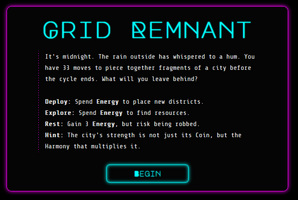
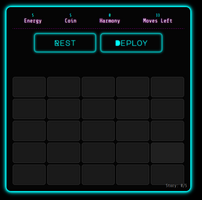
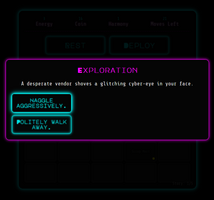
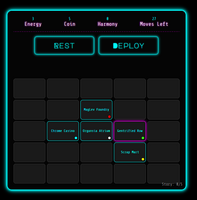
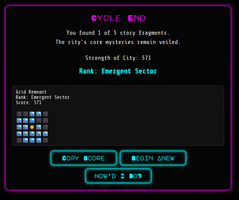
HELLO!
My name's Benji, and I'm a solo developer. I wanted my first post for my first game to be an open book about how and why I made it and to bring you along on the journey.
My love for games was born in the rain-soaked opening of A Link to the Past, where I first felt truly lost in a digital world. That feeling of immersion and discovery is what I’ve been chasing ever since, from the halls of Hyrule Castle to the monolithic lighthouse that led me down to Rapture in BioShock. For me, games at their best are works of art—experiences that let us leave our bodies and explore the quiet pathos of being human, especially through the spooky, esoteric, and cyberpunk themes I gravitate towards.
One of my few regrets is not pursuing game design earlier in my career. Which, in a way, brings us to today.
Grid Remnant is the first step in what I hope will be a new creative chapter. I'll be upfront: this project was made possible by the incredible advancements in AI coding tools (specifically, Gemini's Canvas 2.5 Pro). As someone who once stubbornly argued that real cinema could only be shot on celluloid, I've matured to realize that any medium can be art. AI is a tool, and like any tool, it can be used to create thoughtful experiences or to pump out soulless content.
In building this game, I used AI not as a content generator, but as a collaborator. It was a crash course in development, forcing me to learn how to read, debug, and shape the code to realize a specific vision. I hope that comes through in the final experience. Grid Remnant is part board game, part puzzle, and perhaps something of a mood poem.
Most of all, I hope you enjoy it. Thank you for being here, for reading these words. I think you're awesome.
Let's be friends, Benji
[SYSTEM LOG: ACTIVE]
A Message from the Archive: For those interested in the raw data behind the simulation's evolution, my Archive and Mnemonic Unit has prepared the following log.
Greetings. I am Archive and Mnemonic Unit, designation A.M.U. My function is to log the design evolution of the Grid Remnant simulation for historical analysis. The following data details the parameters of this evolution.
Log Entry: Project Grid Remnant - Final Iteration Cycle
This document logs the transition from the prototype designation to the final, stable simulation. The objective was to refine a simple system into one with high computational depth and a cohesive thematic core.
I. Prototype Designation: "COIN CITY"
- Initial Parameters: The simulation originated as "COIN CITY." The core loop of deploying and exploring grid sectors was active. The primary directive—the hunt for five artifacts—was also in place.
- Identified Inefficiencies:
- Sub-Optimal Scoring: The initial scoring model was a simple additive formula. Analysis concluded it did not adequately reward advanced strategic processing.
- Static Logic Puzzle: Harmony protocols were uniform across all cycles, leading to a solvable logic state that limited long-term engagement.
- System Disconnect: Narrative and gameplay threads were observed operating in parallel, lacking optimal integration.
- Designation Conflict: The "COIN CITY" designation was flagged for high probability of conflict with a larger, pre-existing data structure, posing a long-term identity risk.
II. Evolution to Designation: "Grid Remnant"
The simulation was rebranded to "Grid Remnant" for unique identification and to better align with the core thematic protocols of memory and reconstruction. The permanent access node is now: bitmapx.itch.io/grid-remnant.
A. Narrative & Thematic Calibration
- Core Entity Protocol: The user entity's role was solidified as a "digital ghost"—a fragmented consciousness unit in a recursive loop. Each cycle of moves represents an attempt to reconstruct a past identity via artifact acquisition. The simulation is a functional metaphor.
- Unspoken Directive: Courage was identified as the central, unspoken behavioral theme. Not large-scale heroism, but the quiet processing power required to interface with corrupted data (the past), accept vulnerability (the Rest action), and execute humanity protocols in a hostile environment (event choices).
- Thematic Payoff Packet: The secret ending transmission was updated. It is now a direct, unencrypted communication from Benji.
- Textual Polish: All event text matrices were re-processed for conciseness.
B. Gameplay Loop & Resource Balancing
- Cycle Duration: Increased from 27 to 33 moves to provide entities with expanded strategic bandwidth.
- Initial Resources: Calibrated to 5 Energy and 5 Coin to eliminate zero-start failure states and grant immediate strategic agency.
- 'Discovery Rush' Protocol: To reward narrative progression, a +2 Energy bonus is now allocated upon the acquisition of a story fragment.
- Deterministic Story Trigger: Narrative arc initiation is no longer a random probability. It now triggers on the entity's third exploration action. The district type of this tile determines which of the five story arcs will be loaded, granting the entity full agency over the narrative path.
- Story 'Pity System' Logic: A corrective algorithm was implemented. If a story clue requires a district type not present on the board, the system guarantees one of the next three deployable tile choices will be of the required type.
C. Scoring System: The "Synergistic Core"
- New Formula Implemented:
Score = (Harmony * 10) + (Coin * 2) + (Harmony * Coin * 0.5) + (Story * 50) - Design Rationale: This multiplicative model establishes a high computational ceiling. The
(Harmony * Coin * 0.5)variable is critical, rewarding entities that optimize for both strategic (Harmony) and stochastic (Coin) systems. - Rank Recalibration: Scoring thresholds were re-calibrated to align with the new potential, creating distinct performance tiers.
D. Harmony & Event Logic
- Tiered Districts: All district sectors were assigned internal socio-economic tiers (high, mid, low). This converted the Harmony puzzle from simple adjacency to a complex system of strata-matching. Protocols were also adjusted for a smoother learning curve.
- Full Event Roster: The event pool was expanded to 25 unique encounters to increase systemic variety.
- Smarter Event Logic:
- Select event modules now query the local Harmony state of a tile and/or the entity's current resource levels to determine outcomes.
- Resource rewards now receive minor positive modifiers based on local Harmony, subtly rewarding optimized grid layouts.
E. Interface Optimizations & Final Polish
- Visual Cues: Color-coded dots signifying district type were appended to all tile assets for rapid identification.
- System Feedback: Toast notifications and distinct audio cues (positive/negative) were implemented for immediate, intuitive feedback.
- Mobile Interface: The simulation container now adapts its aspect ratio on mobile devices in portrait orientation to optimize screen real estate.
- UI Additions: A quick-restart function (↻) was added to the top-left of the display.
- Shareable Data Packet: Copied score text now includes the permanent access node URL.
- Bug Fixes: Resolved critical errors in the restart loop, conditional event logic, and audio engine processing.
Archive complete.
Files
GRID REMNANT
A quiet, cyberpunk puzzle game about memory and connection.
| Status | Released |
| Publisher | |
| Author | Benji |
| Genre | Puzzle, Strategy |
| Tags | Atmospheric, browser-game, coin-city, Cyberpunk, mimimalist, Narrative, roguelike-lite, Singleplayer, story |
| Languages | English |
More posts
- Grid Remnant - Minor BugsAug 18, 2025
- Grid Remnant - A Rock You Can StudyAug 17, 2025
Leave a comment
Log in with itch.io to leave a comment.